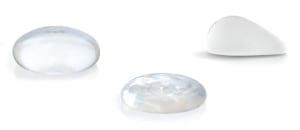Breast implant selection
Posted July 11, 2015 in Breast Procedures
Help me choose an implant
One of the biggest choices that women have to make when deciding on a type of breast implant is selecting the fill material of the implant. In the United States, that choice comes down to two options – saline or silicone. What exactly are the differences between the two? To start, both saline and silicone implants are made from an outer shell composed of silicone. The main difference is in what is on the inside of the shell. Saline implants are filled with sterile salt water. They are usually inserted empty into the breast, and then filled up with normal saline once they are in position. Silicone implants, on the other hand, are pre-filled with silicone gel, which is a thick, sticky fluid. They come pre-filled, and require a slightly longer incision to insert them. Another type of implant is the form-stable implant, commonly referred to as gummy bear implants. These implants are also filled with silicone gel, but the consistency of the gel is thicker than what is found in traditional silicone implants. In the United States, saline breast implants are available to women over the age of 18 for breast augmentation and to any women for breast reconstruction, whereas silicone breast implants are available to women over the age of 22 for breast augmentation and to any woman for breast reconstruction.
Another decision that must be made in selecting an implant is the consistency of the outer shell. The outer surface of the implant can be either smooth or textured. Smooth breast implants are the softest feeling, and can move freely within the breast implant pocket, which may give more natural movement. However, due to the smooth surface, there may also be more visible rippling of the implant surface. A textured breast implant, on the other hand, has a rougher surface. Scar tissue tends to stick to this surface, which limits the movement of the breast implant within the pocket. The risk of developing a tight capsule around the breast implant is less with a textured implant.
Once the style, size, and shape of the breast implant has been determined, the final variable that should be considered is the profile of the implant. This refers to the distance a breast implant projects outward from the chest wall. For a given volume, low profile breast implants have the least amount of projection, whereas ultra-high profile breast implants have the greatest amount of projection. Usually, lower profile implants tend to have a wider base width than a higher profile implant.
What about the risks?
The risk profile of saline and silicone breast implants are similar. Both have an approximately 1% chance of leaking or rupture per year. If a saline breast implant ruptures, the implant will deflate which causes an immediate difference in the size and shape of the breast. The saline that leaks out from the implant will be absorbed by the body, and not cause any health risks. On the other hand, when a silicone implant ruptures there may not be any noticeable difference in the appearance of the breast. This is usually due to the silicone becoming trapped between the scar tissue that forms around the implant, and the implant itself. Leaking silicone gel is not thought to cause any health risks; however, it may eventually cause changes in the shape of the breast or even breast pain. Form-stable silicone implants maintain their shape even when the implant shell is broken. With both a ruptured saline and silicone breast implant, there is no emergent need to remove the implant, although the implant may have to be eventually removed and/or replaced.
One of the other main risks of breast implants is the formation of scar tissue around the implant, also known as a capsule. Sometimes the capsule can harden and become firm, a condition known as capsular contracture. There are varying degrees of capsular contracture, but in moderate to severe cases the breast can become hard, the breast shape can become distorted, and there may be pain in the breast. Usually once this occurs the breast implant and scar tissue surrounding it should be removed, and then replaced with another breast implant if that is the woman’s desire.
Final decision
Ultimately the choice of breast implants boils down to personal preference of the woman. The factors that should be considered are the fill material, and the size, shape, and profile of the breast implant. A thorough discussion between the patient and the plastic surgeon regarding the pros and cons between the various choices of breast implants can aid in the decision making process.

